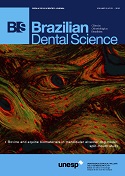Accuracy of color measurement of endondontically treated teeth after aging
DOI:
https://doi.org/10.14295/bds.2016.v19i3.1270Abstract
Objective: The aim of this study was to compare the accuracy of three different modes of a spectrophotometer (Vita Classical, 3D-Master and CIE L*a*b* system) in the evaluation of color alteration in endodontically treated teeth. Material and Methods: The root canal treatment of forty-five sound human canines was performed. Color measurements were performed before the endodontic treatment (baseline), andafter6monthsof water storage. Shade matching was performed using a spectrophotometer (Vita Easyshade) in three different modes: Vita Classical, 3D-Master and CIE L*a*b* coordinates. The color change (?E value) for the three methods were assessed in each sample and analyzed by multiple linear regression analysis. L*, a* and b* values were analyzed by t-test. The significance level was set at 5%. Results: According to the digital evaluation, no statistically significant differences were found between the CIE L*a*b*,Vita Classical and 3D-Mastermodes. However, a significant difference was found (p<0.001) for the ?E values, with the CIE L*a*b* mode presenting greater accuracy to detect color alterations. Conclusion: CIE L *a*b* method properly correlates to Vita Classical and 3D-Master modes. However, Easyshade can easier detect color changes if used in the CIE L*a*b* mode, which leads to more accurate results.
Downloads
Downloads
Additional Files
Published
How to Cite
Issue
Section
License
Brazilian Dental Science uses the Creative Commons (CC-BY 4.0) license, thus preserving the integrity of articles in an open access environment. The journal allows the author to retain publishing rights without restrictions.
=================




























